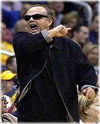|
bark. (verb) To address someone loudly and abruptly, perhaps (but not necessarily) with the intent to intimidate, is to “bark” at that person. Some folks seem to bark even when it is not their intent to intimidate, though the impact may be much the same. Some of us are just naturally loud and abrupt.
Barking seems to be a frequent description of the way male athletes address one another and especially how they and fans address officials. The Florida State University newspaper, FSView & Florida Flambeau, wrote excitedly of just such an incident. “Jack Nicholson—stood up following a questionable call by a referee
and started barking obscenities at the ref, nearly getting ejected from
the arena.” |
1. Klein, Adam. 2003. Home is where the banners hang. FSView & Florida Flambeau. fsunews.com, Jun 30. Accesed Feb 7 2008 from http:// media.www.fsunews.com/ media/storage/ paper920/ news/2003/06/30/ Sports/Home-Is.Where. The.Banners.Hang-2364990.shtml. |
||||||||||||
Bark (linguistics). An interval on the Bark Frequency Scale psychoacoustical scale. The scale ranges from 1 to 24 Barks, corresponding to "bands of hearing" |
2. Wikipedia contributors. 2008. Bark Scale. Wikipedia. Wikimedia Foundation. Accessed Jan 9 2009 from http://en.wikipedia.org/wiki/Bark_scale. 3. Smith, Julius O. 1999. The Bark Frequency Scale. JOS Home. Center for Computer Research in Music and Acoustics (CCRMA),. Accessed Jan 9 2009 from http:// ccrma.stanford.edu/ ~jos/bbt/ Bark_Frequency_Scale.html. |
||||||||||||
A barker. (noun) A barker or a shill shows the persistence of a dog barking. Fewer and fewer venues use barkers, instead relying on flashing signs that read “live nude girls.” It is a dying art, though maybe not so great a loss. |
|||||||||||||
bark like a dog. This phrase might seem synonymous with the shorter “bark,” in which the simile is implied but not stated. However, such a reading misses the nuances created by making it an explicit simile. The added phrase “like a dog” forcibly calls the reader's or listener's attention to the doggishness of the action. Indeed, when a human “barks like a dog,” it is not simply that s/he is being loud and abrupt in human language. More likely this person is making sounds that are literally like those that dogs make. These might be uttered in those moments when, because of physical exertion, inebriation, sexual excitement, and/or emotional intensity, words desert us and we make non-linguistic (i.e., animal) sounds. This is described by none other that Dante Alighieri in telling the tale of the Trojan Queen, Hecuba. Already mourning over the fall of Troy, when she saw her daughter Polyxena drowned on the beach, “Bereft of sense she bark'd as barks the hound, So much the force of grief her mind had wrung.” |
4. Dante, Alighieri, and John Wesley Thomas, trans. 1859. The Trilogy; or Dante's Three Visions. London: H. G. Bohn. 308. | ||||||||||||
| |
|||||||||||||
| About the illustrations: Figure 1 shows a man barking into the telephone. © 2008 Jupiterimages Corporation.
Figure 2 is Jack Nicholson barking at the referees. Photo by Mark J. Terrill. “Nicholson gets court rage.” © 2003 Associated Press. Figure 3 Shows the relationship between Hertz and Bark Frequencies. The image is a substantially modified version of an illustration from Chen, et al's presentation on W.A.V.S. compression.
Figure 4 shows a barker, a shill for a carney and burlesque show. Collaged image by the author. It also makes me think of the host of Truth or Consequences, Bob Barker (figure 6, an unauthorized image from a fan web site). Figure 5 is a self-portrait of a young woman barking like a dog. You can easily see her doggy posture, her eyes gazing upwards, tongue lolling. This image shows the more doggish qualities associated with “bark like a dog.” Compare this with Figures 1 and 2 to see the difference. Image used with permission, attribution withheld by request. Figure 6 shows the young Brenda Chenowith from Season 1 of Six Feet Under. |
5. Chen, Alex, Nader Shehad, Aamir Virani, and Erik Welsh. 2008. Psychoacoustic Model. W.A.V.S. Compression. Rice University. Accessed Jan 9 2009 from http://is.rice.edu/~welsh/elec431/psychoAcoustic.html. |
||||||||||||
| 6. Bates, Kathy. 2001. The Book. In Six Feet Under, A. Ball, series director. | |||||||||||||
| see also: bark is worse than his bite; bark up the wrong tree; barking heads cf: at bay; waffle; woof |
Last updated: August 29, 2009 |
|
|||||||

|







